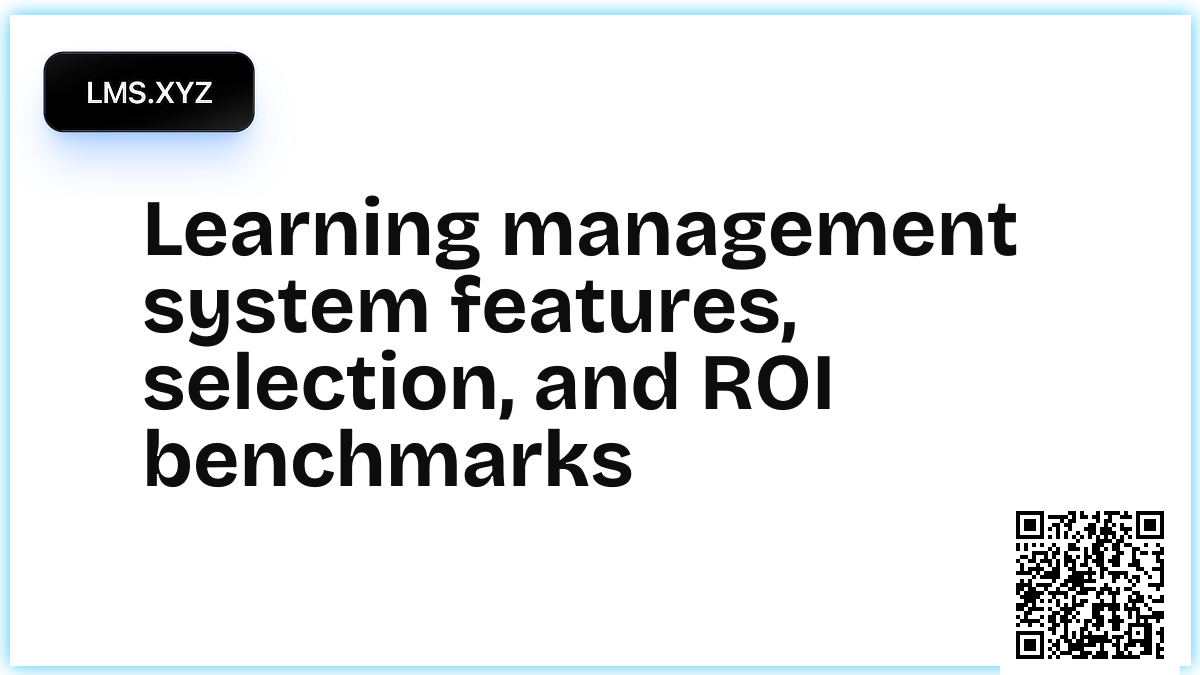Learning management system features, selection, and ROI benchmarks

Learning management systems sit at the center of digital training. Buyers ask the same questions every cycle: what capabilities matter, how to integrate, and how to prove value. A clear view of features and outcomes reduces risk and shortens time to launch.
Core features buyers evaluate
Most teams start with content authoring, delivery, and assessment. Built in editors help small teams publish fast, while SCORM and xAPI support protect legacy packages. Quizzing, assignments, and proctoring ensure reliable measurement.
Modern UX is now a baseline. Learners expect responsive pages, clear progress indicators, and mobile access. Administrators need search, bulk actions, and safe import flows. These details drive adoption and support outcomes.
Analytics is a second pillar. Leaders want cohort trends, skill coverage, and risk flags for compliance courses. Exports to a warehouse enable custom dashboards. Alerting helps managers act before deadlines slip.
Integrations that reduce manual work
Integrations define daily workload and data quality. Single sign on improves security and reduces password resets. Directory sync maps roles and groups to courses. For training at scale, job codes and locations steer enrollments.
HRIS, CRM, and ticketing connections close the loop. Completion data can update a worker profile, unlock system access, or file a badge. Webhooks allow real time reactions to enrollments and failures. These integrations cut manual effort and errors.
Video delivery is another key link. Native players should handle captions, variable speed, and chapter markers. Storage costs can be high, so direct uploads to a cloud bucket help. Transcripts improve search and accessibility.
Standards that protect content investments
Content standards reduce vendor lock in. SCORM remains common for compliance. xAPI enables richer statements and flexible tracking across tools. LTI simplifies deep links to third party tools inside a course shell.
Choose platforms that import and export without loss. Versioning and package validation prevent silent failures. These details matter when audits arrive or when you change vendors.
Security, privacy, and compliance
Security reviews focus on data at rest, data in transit, and identity. Role based access, audit logs, and least privilege defaults are standard asks. Encryption keys should be rotated and tracked.
Privacy requirements vary by region and sector. Data retention controls, consent flags, and clear processing maps help pass reviews. Access to personal data should be traceable. Redaction tools help respond to data requests.
Accessibility is non negotiable. WCAG targets guide design and testing. Captions, alt text, and keyboard navigation support broad access. A platform that ships with accessible components lowers long term risk.
Content strategy that scales
Teams often start with a small library, then face a backlog. A repeatable content workflow avoids bottlenecks. Use templates for learning paths, set review cycles, and archive stale modules. Microlearning helps fill gaps between larger courses.
Skill frameworks connect learning to work. Map courses to roles and competencies so managers can assign with intent. Pre and post assessments show gain, not just completion. That evidence supports budget renewals.
Implementation playbook
Successful rollouts follow a predictable path. Start with a pilot group that reflects the broader audience. Gather feedback on navigation, enrollment rules, and reporting. Fix friction before a wide launch.
Train administrators early. Short, role based sessions work best. Provide job aids for common tasks and escalation contacts for edge cases. Good admin enablement prevents support queues from spiking.
Define operating metrics before launch. Agree on active users, completion rates, and time to publish. Build a weekly dashboard and review it with stakeholders. Consistent, simple metrics beat complex reports that go unread.
ROI modeling and benchmarks
ROI comes from avoided costs, risk reduction, and performance gains. Start by quantifying manual work removed by integrations. Add savings from fewer classroom sessions and travel. Include the value of faster onboarding.
Risk reduction is material for regulated teams. On time completion lowers penalties and audit exposure. Documented training supports contract bids. These benefits are real and measurable.
Performance gains show up in productivity and quality. Shorter time to proficiency reduces ramp for new roles. Refresher modules cut error rates. Tie these metrics to business outcomes where possible.
Set a simple model that finance accepts. List costs across licenses, implementation, and content production. Compare to benefits across labor, risk, and performance. Update the model with live data each quarter.
Buyer checklist
- Security and privacy: encryption, logs, access controls
- Content support: SCORM, xAPI, native authoring
- Integrations: SSO, HRIS, CRM, webhooks
- Analytics: cohorts, exports, alerts
- Accessibility: WCAG support and testing
- Operations: admin UX, bulk actions, API limits
Bottom line
Learning management systems deliver value when aligned to clear goals. Favor platforms that integrate well, respect standards, and ship strong analytics. Track outcomes against a simple model and adjust. That approach produces results that stand up to scrutiny.
